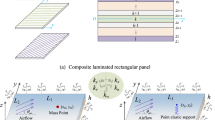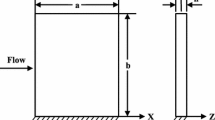Abstract
The objective of this paper is to study the feasibility of panel flutter emulation using a few concentrated forces. The concentrated forces are considered to be equivalent to aerodynamic forces. The equivalence is carried out using surface spline method and principle of virtual work. The structural modeling of the plate is based on the classical plate theory and the aerodynamic modeling is based on the piston theory. The present approach differs from the linear panel flutter analysis in scheming the modal aerodynamics forces with unchanged structural properties. The solutions for the flutter problem are obtained numerically using the standard eigenvalue procedure. A few concentrated forces were considered with an optimization effort to decide their optimal locations. The optimization process is based on minimizing the error between the flutter bounds from emulated and linear flutter analysis method. The emulated flutter results for the square plate of four different boundary conditions using six concentrated forces are obtained with minimal error to the reference value. The results demonstrated the workability and viability of using concentrated forces in emulating real panel flutter. In addition, the paper includes the parametric studies of linear panel flutter whose proper literatures are not available.










Similar content being viewed by others
References
Hedgepeth JM (1957) Flutter of rectangular simply supported panels at high supersonic speeds. J Aeronaut Sci 24(8):563–573. https://doi.org/10.2514/8.3908
Eisley JG (1956) Panel flutter in supersonic flow. Ph.D. thesis, California Institute of Technology
Dugundji J (1966) Theoretical consideration of panel flutter at high supersonic Mach numbers. AIAA J 4(7):1257–1266. https://doi.org/10.2514/3.3657
Durvasula S (1967) Flutter of simply supported, parallelogrammic, flat panels in supersonic flow. AIAA J 5(9):1668–1673. https://doi.org/10.2514/6.1966-474
Olson MD (1970) Some flutter solution using finite elements. AIAA J 8(12):747–752. https://doi.org/10.2514/3.5751
Sander G, Bon C, Geradin M (1973) Finite element analysis of supersonic panel flutter. Int J Numer Methods Eng 7(3):379–394. https://doi.org/10.1002/nme.1620070313
Sylvester MA (1957) Some experimental studies of panel flutter at Mach number 1.3. NTRS, NACA-TN-3914
Fung Y (1960) A summary of theories and experiments and panel flutter. California Institute of Technology, Pasadena
Dowell EH (1970) Panel flutter—a review of aeroelastic stability of plates and shells. AIAA J 8(3):385–399. https://doi.org/10.2514/3.5680
Bismarck-Nasr MN (1992) Finite element analysis of aeroelasticity of plates and shells. Appl Mech Rev 45(12):461–482. https://doi.org/10.1115/1.3119783
Jie Z et al (2011) GVT-based ground flutter test without wind tunnel. In: 52th AIAA/ASME/ASCE/AHS/ASC structures. Structural dynamics and material conference. https://doi.org/10.2514/6.211-1942
Harder RL, Desmarais RN (1972) Interpolation using surface spline. J Aircr 9(2):189–191. https://doi.org/10.2514/3.44330
Srinivasan RS, Babu BJC (1985) Flutter analysis of cantilevered quadrilateral plates. J Sound Vib 98(1):45–53. https://doi.org/10.1016/0022-460X(85)90401-8
Abbas LK, Rui X, Marzocca P (2012) Panel flutter analysis of plate element based on the absolute nodal coordinate formulation. Multibody Syst Dyn 27(2):135–152. https://doi.org/10.1007/s11044-011-9268-5
Acknowledgements
The work is performed under High-Speed Vehicle Research Center (HVRC) Program, funded by Defense Acquisition Program Administration (DAPA) and Agency for Defense Development (ADD).
Author information
Authors and Affiliations
Corresponding author
Rights and permissions
About this article
Cite this article
Dhital, K., Han, JH. Panel Flutter Emulation Using a Few Concentrated Forces. JASS 19, 80–88 (2018). https://doi.org/10.1007/s42405-018-0009-3
Received:
Revised:
Accepted:
Published:
Issue Date:
DOI: https://doi.org/10.1007/s42405-018-0009-3




